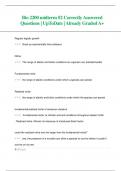Class notes
College aantekeningen Data Protection Technologies (5284DAPT6Y)
- Course
- Institution
Uitgebreide aantekeningen van alle hoorcolleges van het vak Data Protection Technologies, dat wordt gegeven op de Universiteit van Amsterdam (UvA) aan de master 'Computer Science'. Extensive summary of all lectures from the course Data Protection Technologies, taught at the University of Amsterd...
[Show more]












